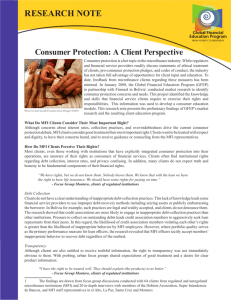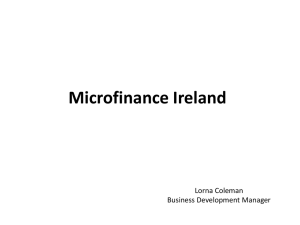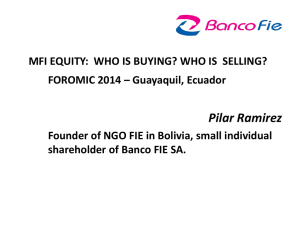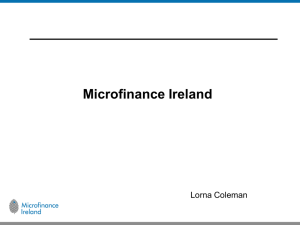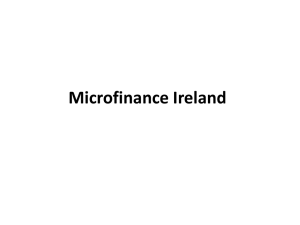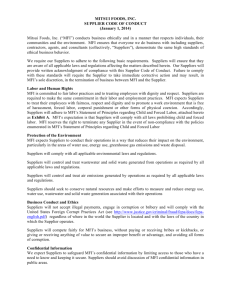Bank Outreach Models
advertisement
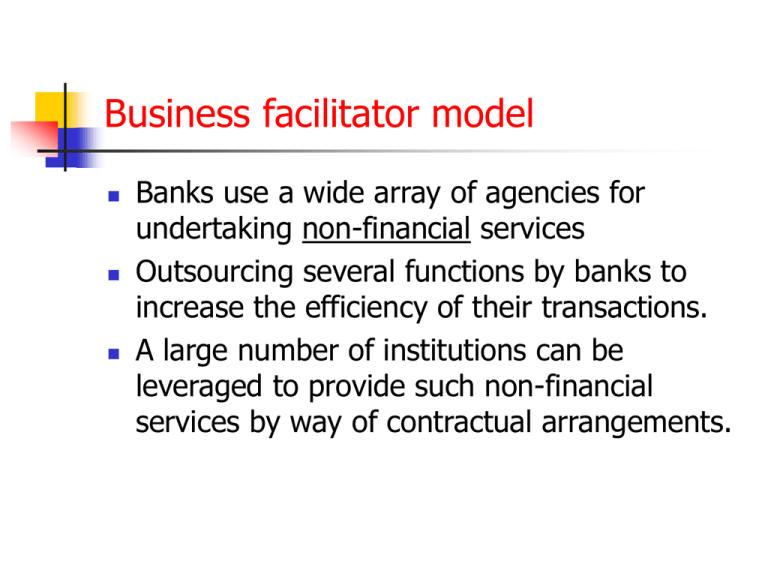
Business facilitator model Banks use a wide array of agencies for undertaking non-financial services Outsourcing several functions by banks to increase the efficiency of their transactions. A large number of institutions can be leveraged to provide such non-financial services by way of contractual arrangements. Non-financial Services Identification of borrowers Collection of application and verification of primary information Marketing of financial products Promoting SHGs/JLGs Post sanction monitoring Follow up for recovery Business facilitator model Agencies include: - NGOs - Functional cooperatives - Postal agents - Insurance agents - Agri clinics - Local youths/retired bank employees Business Correspondent Model Use several institutions as agents for providing financial functions on behalf of banks. Function as “pass through” agents. Disbursal of small value credit Recovery of principal and interest The correspondent is authorized to accept/deliver cash subject to the cap fixed by bank. Issues Internal policy for identifying agencies Risk Management Strategies in the banks Rating of the agencies Due diligence to be carried out on the agencies Code of conduct for operation Monitoring and review arrangements Selection criterion Significant rural presence Satisfactory dealing with banks Reference of third party known to bank Rating Due diligence Due Diligence – Indicative Parameters Charter and Registration - objectives of organization permit it to undertake the proposed activities Presence in the area Management and governance structure Manpower quality Accounting system Assessment of donors and peers MFI-Bank Partnership Model MFI sources loans directly in the books of the bank MFI continues to monitor and recover loans thus disbursed. The NGO/MFI continues to perform the role of social intermediary The financial intermediation and therefore the credit risk is left to the bank. MFI-Bank Partnership Model This releases the MFIs from their capital constraints and allows them to achieve rapid increase in outreach. The bank relies on the MFI’s field operations for collection and supervision. MFI evaluates, recommends, originates the loans, helps in disbursal and subsequently tracks and collects the loans. The MFI collects a service charge from the borrowers to cover its transactions costs and margins. MFI-Bank Partnership Model Loan contracts directly between the bank and the borrowers - it does not reflect on the balance sheet of the MFI - The financial structure attempts to separate the risk of the MFI from the risk of the underlying portfolio. MFI-Bank Partnership Model Alignment of incentives with a first loss guarantee structure (FLDG) -The financial structure requires the MFI to provide a guarantee (a first loss default guarantee) - through FLDG the bank shares the risk of the portfolio with the MFI up to a certain limit. MFI-Bank Partnership Model FLDG makes the provider of the guarantee liable to bear losses up to a certain specified limit, say for the first 10 or 20 percent of loss on the portfolio. The quantum and pricing of the FLDG depend on the operating capability and maturity of the MFI MFI-Bank Partnership Model Transfer of implicit capital from the bank to the MFI through an overdraft facility - Along with advancing of credit to meet the demand of the clients, the bank often provides an overdraft (OD) facility to the MFI. - The OD facility is equivalent to the amount which the MFI is liable to provide as the FLDG. MFI-Bank Partnership Model The OD is drawn only in the event of default. On default, the MFI is liable to pay a penal rate of interest on the amount drawn down from the OD facility. MFI-Bank Partnership Model Partnership model and securitization - The microfinance assets originated under this partnership model facilitate participation of a wider investor base through the process of securitization. - sale of portfolio by the originating bank to another bank MFI-Bank Partnership Model When the microfinance pools become larger in size, issuance of securities that are backed by microfinance assets become conceivable. The process catalyses development of a secondary market for microfinance where some entities specialize as originators and others emerge as buyers/investors. MFI-Bank Partnership Model The MFI also experiences rating arbitrage and the improved rating results in lower costs of financing. MFI-Bank Partnership Model (i) lack of clarity with regard to the rights and obligations of the MFIs vis-à-vis the banks since although the MFI is responsible to ensure recovery of loan, the loan documents are executed by the ultimate borrowers in favour of the bank, (ii) maturity mismatch between the repayment schedule drawn by the bank vis-à-vis the MFI and the repayment schedule between the ultimate borrowers and the MFI, (iii) the amount of fixed deposits collected as margin from the MFI by the bank is often beyond the financial capability of the MFI, MFI-Bank Partnership Model (iv) imprudent selection of MFI as partner in a bid to build up portfolio rapidly, and (v) risk of multiple financing by more than one bank.


